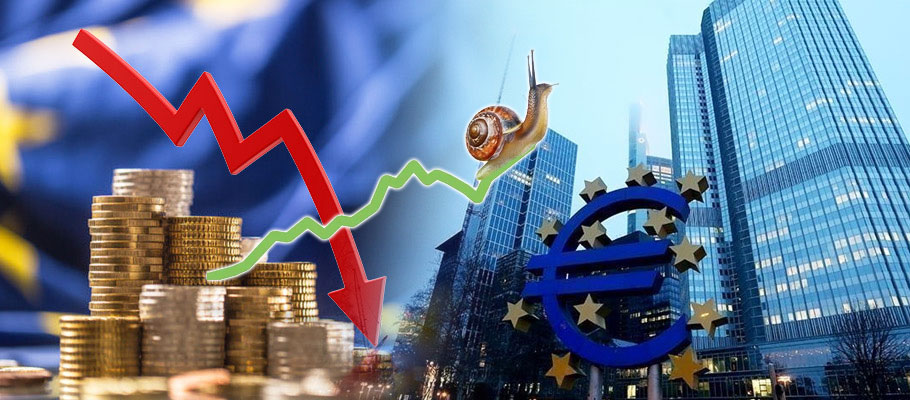
Published: August 27th, 2025
A manufacturing sector pulling out of recession, cooling trade conflict and a slow-down in the pace of inflation have helped push-up Eurozone private sector activity to an 12-month high.
Eurozone growth accelerated in July, inching the bloc's S&P Global Composite PMI up to 51.0 from 50.5 in June. Consensus was looking for a more modest advance of 50.8.
The services sector drove most of the expansion, taking the business activity index to 51.2, the strongest print since the start of 2025.
Manufacturing output held at just north of 50 with a reading of 50.68, though the wider sector figure rose to 49.7 for a 36-month high.
Helping enable business growth was a reduced pace of inflation, which fell to a nine-month low and below the monthly average for the year to date.
On the downside, business confidence sagged somewhat, with sentiment turning gloomy in France but sunnier in Germany, where prospects for future growth look more baked-in.
A note to investors from ING Bank said the Eurozone recession in manufacturing ‘is drawing to a conclusion,’ though analysts warned that political tensions in France could end the upswing.
The Eurozone;s second largest economy is increasingly seen as a drag on growth, with the country's headline Composite PMI reading coming in at 49.8, below the 50 level that separates contraction and expansion.
In February 2025, Standard & Poor's Eurozone Composite PMI rating remained steady at 50.2 in February, up just slightly from 50.1 in January.
A second straight month of marginal growth pointed to a decline in overall business sentiment, the ratings agency said, while inflationary signals had resurfaced. The ratings agency cast doubt on the strength of a recent recovery and highlighted the significance of political uncertainty in Germany and a contraction in French economic output.
In a note responding to the S&P survey, analysts at ING Bank wrote that ‘the latest figures suggest that month-on-month growth in the bloc is around zero percent. That isn't cause for celebration, but isn't necessarily cause for alarm either. Nothing in the S&P PMI reading suggests activity is deteriorating further.’
ING noted that signs of Eurozone weakness were concentrated in France as Germany, while other countries in the bloc all demonstrated output growth.
In the services sector, which had been a key driver of Eurozone growth, the PMI reading fell to 50.6 from 51.2, a three-month low. Manufacturing, however, showed signs of calm, with the PMI rising to 47.3, a seven-month high.
In Germany, the PMI rose to a nine-month high of 51.0. At the other end of the spectrum, the bloc's number two economy, France, saw its sharpest economic slump in almost a year and a half, with the PMI cratering to 44.5 thanks to sharp declines in services output.
‘France is firmly in recession with no end in sight,’ ING added. ‘The negative reading is especially worrying as it's rooted in the services sector, which had been a resilient sector performer.’
Amid Germany's Spring 2025 elections and the Trump administration's ongoing tariff threats, political instability is once again impacting Eurozone growth.
In June of last year, a surge in EU-skeptic political wins and the calling of a snap election in France put the Euro under broad pressure.
Right-wing parties did particularly well in the June 2024 European Parliamentary elections, especially in Italy and France, where anti-immigration parties including Brothers of Italy (FdI) and National Rally (RN) scored notable wins. French President Emmanuel Macron surprised pundits by calling snap elections for the Assemblée Nationale on the result, adding more political uncertainty to the Eurozone.
An analyst note from Milan-based UniCredit said the Euro had been ‘forced into retreat’ after the election result. This has happened before in the aftermath of European Parliament elections, however this time the cause is a rise in ‘Euro sceptic and anti-European parties, which have made gains in the major EU economies. If those are reflected in the upcoming elections for the French National Assembly, it could complicate policymaking.’
Sterling found support amid the continental turmoil, rising against all G10 peers except the US Dollar.
The Pound to Euro rate saw a lift to 1.1823, extending a rally that began with a robust US jobs print that reduced the odds of interest rate cuts by the US Federal Reserve. That in turn reduced the likelihood of UK rate cuts, since traders were betting the Bank of England would fall in line with the Fed in putting off the beginning of another rate-cutting cycle.
It was a different story for the pair in December 2024 when analysts were predicting a slowing UK economy would prompt a Spring rate cut by the Bank of England.
A report by Deutsche Bank's Forex Strategy Unit suggested Sterling could sink against the Euro to levels last seen during the mini crisis set off by former Prime Minister Liz Truss and her disastrous budget of September 2022.
The bank's analysts said a cooling UK economy could prompt the Bank of England to cut interest rates in May, leading to a decline in the Pound's value. In a report published mid-December, Deutsche said the expected speed and timing of the transition from hiking to cutting for G10 central banks ‘will be a significant influencer over their respective currencies next year.’
Under that scenario, Sterling would be disadvantaged by BoE policymakers, who Deutsche believed would cut the Bank Rate in May, even before the US Federal Reserve and European Central Bank made similar moves, closer to mid-year 2024.
‘The monetary policy tightening undertaken this year is beginning to cascade through the UK economy,’ Deutsche's report says. ‘Housing prices are beginning to move into correction territory, but could fall further. The reduction in real estate activity hasn't impacted labour markets yet. When it does, the signs of economic slowdown will become clear very quickly.’